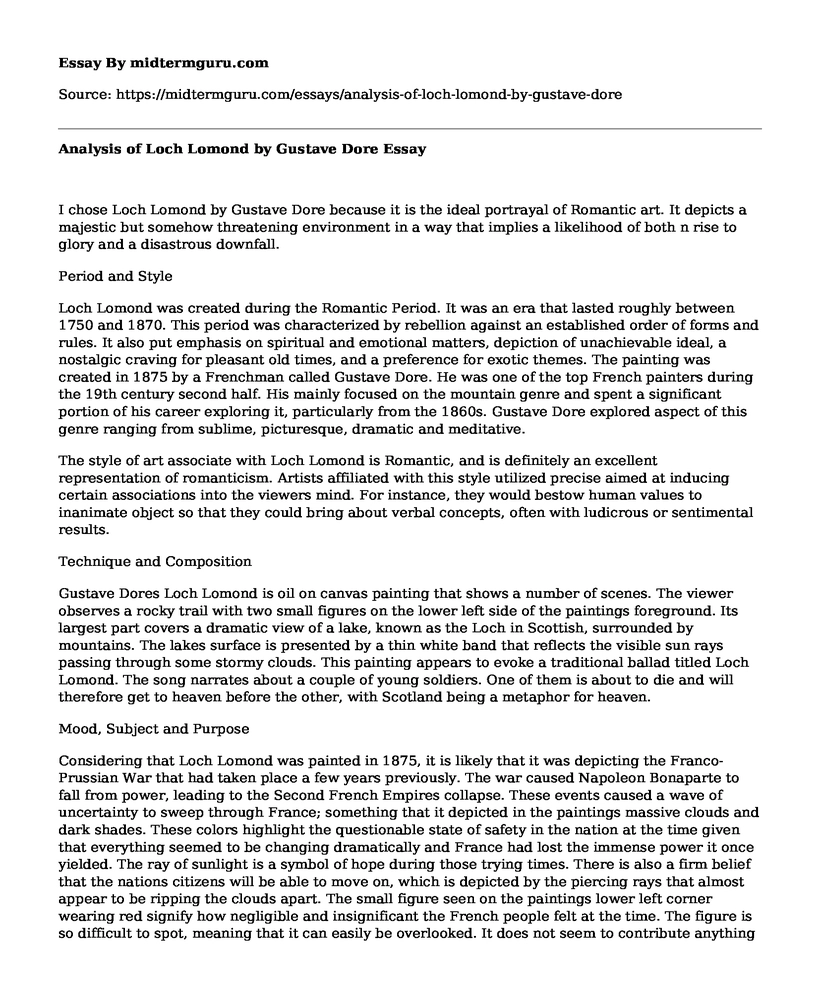I chose Loch Lomond by Gustave Dore because it is the ideal portrayal of Romantic art. It depicts a majestic but somehow threatening environment in a way that implies a likelihood of both n rise to glory and a disastrous downfall.
Period and Style
Loch Lomond was created during the Romantic Period. It was an era that lasted roughly between 1750 and 1870. This period was characterized by rebellion against an established order of forms and rules. It also put emphasis on spiritual and emotional matters, depiction of unachievable ideal, a nostalgic craving for pleasant old times, and a preference for exotic themes. The painting was created in 1875 by a Frenchman called Gustave Dore. He was one of the top French painters during the 19th century second half. His mainly focused on the mountain genre and spent a significant portion of his career exploring it, particularly from the 1860s. Gustave Dore explored aspect of this genre ranging from sublime, picturesque, dramatic and meditative.
The style of art associate with Loch Lomond is Romantic, and is definitely an excellent representation of romanticism. Artists affiliated with this style utilized precise aimed at inducing certain associations into the viewers mind. For instance, they would bestow human values to inanimate object so that they could bring about verbal concepts, often with ludicrous or sentimental results.
Technique and Composition
Gustave Dores Loch Lomond is oil on canvas painting that shows a number of scenes. The viewer observes a rocky trail with two small figures on the lower left side of the paintings foreground. Its largest part covers a dramatic view of a lake, known as the Loch in Scottish, surrounded by mountains. The lakes surface is presented by a thin white band that reflects the visible sun rays passing through some stormy clouds. This painting appears to evoke a traditional ballad titled Loch Lomond. The song narrates about a couple of young soldiers. One of them is about to die and will therefore get to heaven before the other, with Scotland being a metaphor for heaven.
Mood, Subject and Purpose
Considering that Loch Lomond was painted in 1875, it is likely that it was depicting the Franco-Prussian War that had taken place a few years previously. The war caused Napoleon Bonaparte to fall from power, leading to the Second French Empires collapse. These events caused a wave of uncertainty to sweep through France; something that it depicted in the paintings massive clouds and dark shades. These colors highlight the questionable state of safety in the nation at the time given that everything seemed to be changing dramatically and France had lost the immense power it once yielded. The ray of sunlight is a symbol of hope during those trying times. There is also a firm belief that the nations citizens will be able to move on, which is depicted by the piercing rays that almost appear to be ripping the clouds apart. The small figure seen on the paintings lower left corner wearing red signify how negligible and insignificant the French people felt at the time. The figure is so difficult to spot, meaning that it can easily be overlooked. It does not seem to contribute anything to the landscape apart from its mere presence. This reflects what the many people in France felt when compared to their governments major changes and acts of war.
Cite this page
Analysis of Loch Lomond by Gustave Dore. (2021, May 27). Retrieved from https://midtermguru.com/essays/analysis-of-loch-lomond-by-gustave-dore
If you are the original author of this essay and no longer wish to have it published on the midtermguru.com website, please click below to request its removal:
- Essay on How to Detect Media Bias and Propaganda
- Essay on Innovation Architecture of Organization and Management of Innovation
- Eminem as the Greatest Rapper - Art Essay Example
- Comparison of the Coliseum and the Parthenon Architecture - Art Essay Example
- Paper Example on Media's Positive Effect on the LGBTQ Community
- Research Paper on New Media Development Contribute To Promote Socialization Function of Public Welfare of Film
- News Example: 2 Men Charged in Minneapolis Triple Slaying







